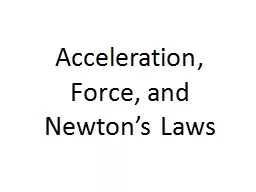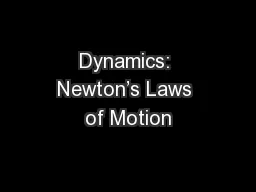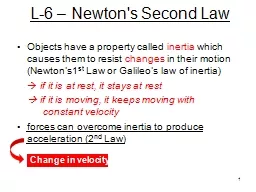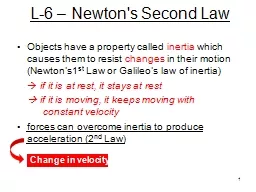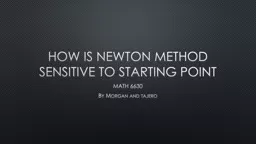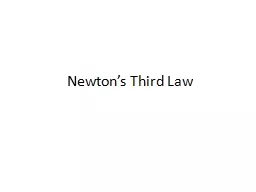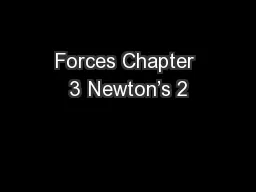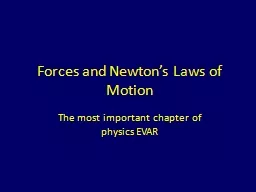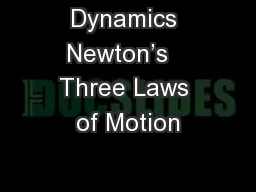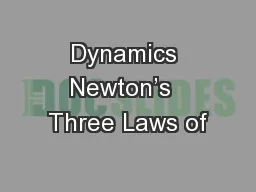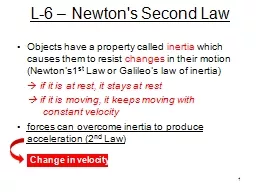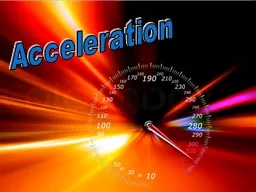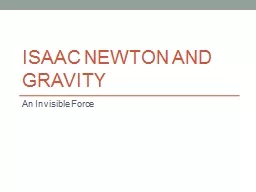PPT-Acceleration, Force, and Newton’s Laws
Author : liane-varnes | Published Date : 2019-11-21
Acceleration Force and Newtons Laws Demonstration Watch what happens when I bounce a tennis ball on the desk What happens to its position Direction What happens
Presentation Embed Code
Download Presentation
Download Presentation The PPT/PDF document "Acceleration, Force, and Newton’s Laws" is the property of its rightful owner. Permission is granted to download and print the materials on this website for personal, non-commercial use only, and to display it on your personal computer provided you do not modify the materials and that you retain all copyright notices contained in the materials. By downloading content from our website, you accept the terms of this agreement.
Acceleration, Force, and Newton’s Laws: Transcript
Acceleration Force and Newtons Laws Demonstration Watch what happens when I bounce a tennis ball on the desk What happens to its position Direction What happens to its speed What happens to its velocity. 1 = 8.85 32 = 283.22 63 = 557.60 94 = 831.97 125 = 1106.34 2 = 17.70 33 = 292.07 64 = 566.45 95 = 840.82 126 = 1115.19 3 = 26.55 34 = 300.93 65 = 575.30 96 = 849.67 127 = 1124.04 4 = 35.40 35 = 309.78 Chapter 2 Section 2 Review. A. . An object at rest remains at rest, and an object in motion remains in motion at constant speed and in a straight line unless acted on by an unbalanced force.. B. . Every action has an equal and opposite reaction. . Physics with Calculus. Chapter 5. Dynamics: Newton’s Laws of Motion. Newton’s First Law. Force. Dynamics – connection between force and motion. Force – any kind of push or pull. required to cause a change in motion (acceleration). Objects have a property called . inertia . which causes them to resist . changes. in their motion (Newton’s1. st. Law or Galileo’s law of inertia). . . if it is at rest, it stays at rest. if it is moving, it keeps moving with constant velocity. Objects have a property called . inertia . which causes them to resist . changes. in their motion (Newton’s1. st. Law or Galileo’s law of inertia). . . if it is at rest, it stays at rest. if it is moving, it keeps moving with constant velocity. starting . point. MATH. . 6630. By. . Morgan. . and . tajero. BACKGROUD. “Newton Method” is also called as Newton-Raphson Method, which been named by Isaac Newton and Joseph Raphson.. Newton Method was first published in 1685 . Whenever one object exerts a force on a second object, the second object exerts an equal and opposite force on the first.. “To every action there is an equal and opposite reaction”. F(AB) = - F(BA). nd. Law of Motion. Newton’s 2. nd. Law of Motion:. . acceleration of an object is in the same direction as the net force on the object. Newton’s 2. nd. Law of Motion . connects . force. , . mass. The most important chapter of physics EVAR. What is a Force?. A force is a push or a pull. Contact forces:. Boat pulling a water skier. Pushing a car with a dead battery. Noncontact forces:. Gravitational attraction of moon to earth. Forces. We have learned that forces . either pushes or pulls.. They come in many varieties:. Gravity & Normal. Kinetic & Static Friction. Electrical & Magnetic. Air resistance. Tension. Nuclear Force. Motion – Day #2. Newton’s Third Law. “Every action has an opposite and equal reaction”.. If one object exerts a force on a second object, the second object exerts the exact same force on the first but in the opposite direction.. Objects have a property called . inertia . which causes them to resist . changes. in their motion (Newton’s1. st. Law or Galileo’s law of inertia). . . if it is at rest, it stays at rest. if it is moving, it keeps moving with constant velocity. V. ector quantity: . magnitude (value) & direction. R. ate . at which an object changes its velocity. . “. How fast an object is getting faster”. If the velocity of an object is changing, it is accelerating!. An Invisible Force. Gravity. Every object pulls on every other object with an invisible force called . gravity. .. There is . gravity. between you and your toy car, but you won’t notice it because it is so weak..
Download Document
Here is the link to download the presentation.
"Acceleration, Force, and Newton’s Laws"The content belongs to its owner. You may download and print it for personal use, without modification, and keep all copyright notices. By downloading, you agree to these terms.
Related Documents

